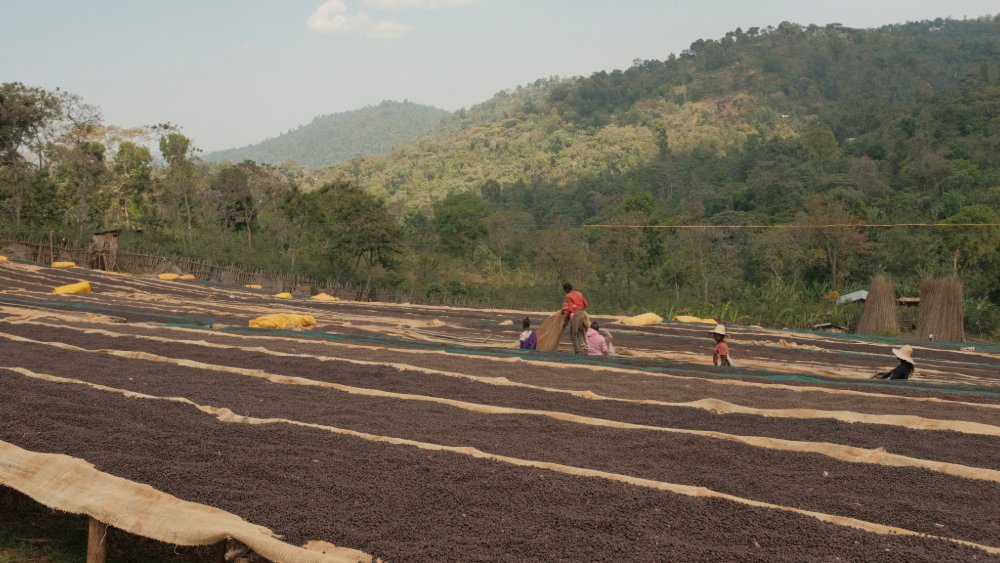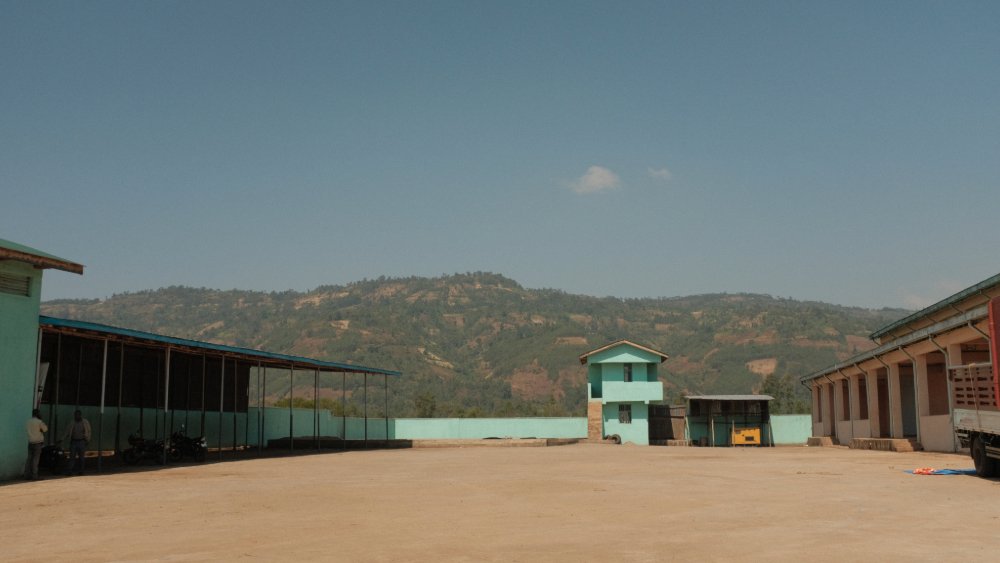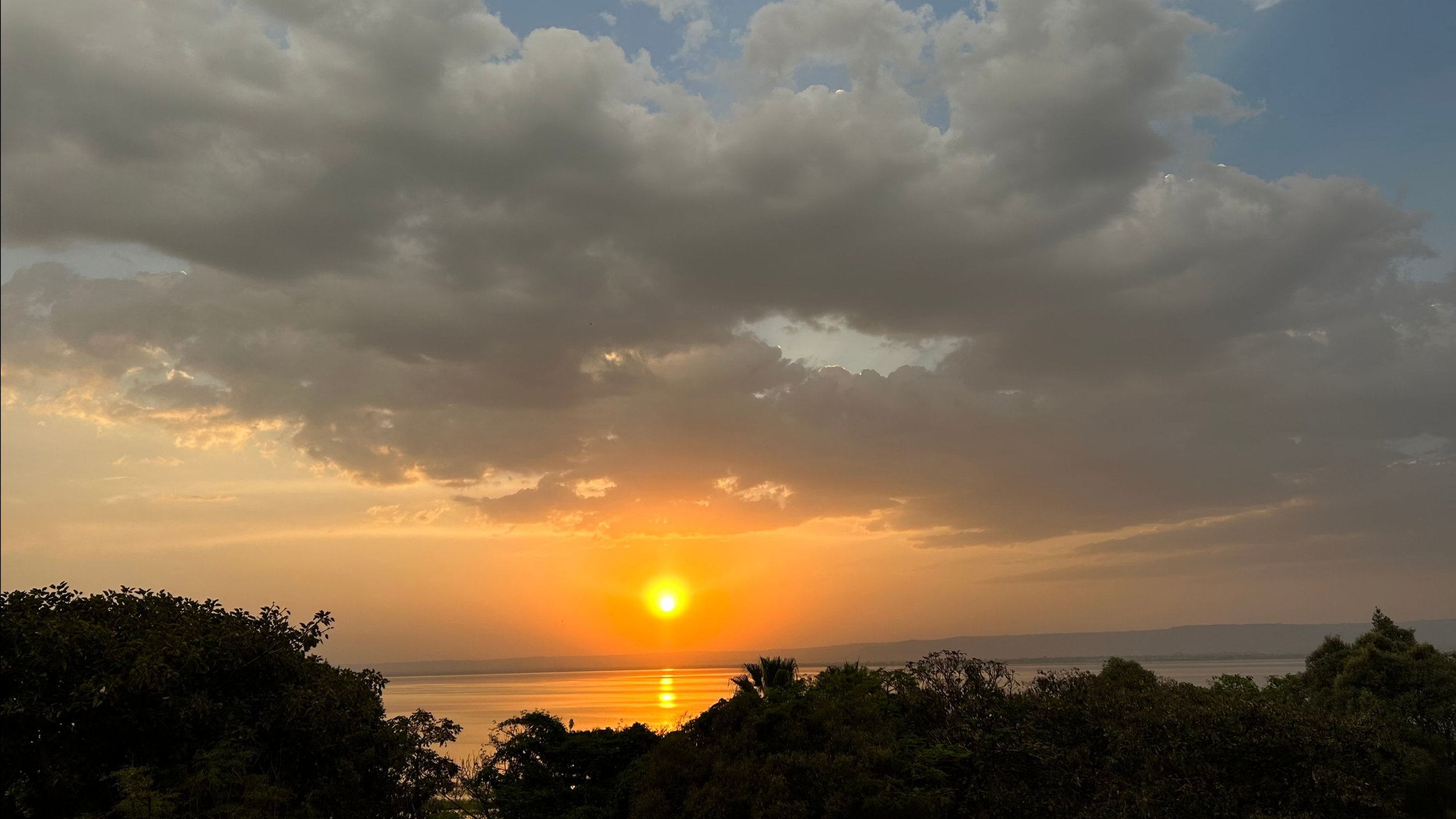Ethiopia.
Traditional coffee in Yirga Chefe
ኢትዮጵያ
Ethiopia, in Amharic, the main language of Ethiopia
Day 1: The time has come to finally visit the homeland of coffee. I last left you in Tanzania, where I flew back to Dar es Salaam to board a flight (after visiting the Indian Ocean) for Addis Ababa. It was sad leaving Tanzania, but my excitement for Ethiopia vibrated through my bones on the plane.
I arrived in the evening and spent the night in the city. Upon waking up, I ventured to Dukamo Coffee, a beautiful café run by Daye Bensa, one of the exporting groups I will actually be traveling with.
Natural coffee, Dukamo Coffee, Addis Ababa
After my delicious and beautiful natural Ethiopian coffee, I was transported back to the airport, where I boarded a flight for Hawassa. The bustling and busy airport was quite confusing, but I somehow ended up on the plane. When I emerged, the landscape was dry, and almost desert-like. The sun beat down on me as I located my driver, Beyene, and companion for the next couple of days. Sadly, he only spoke Amharic, and a few words in English, so most of the drive was filled with Google translate and laughter. Him constantly telling me to ‘enjoy.’
Beyene works for Primrose, one of the many exporting groups in Ethiopia, started in 2010, constructing washing stations throughout the many producing regions of the country to process and export coffee throughout the world. Our journey started with some traditional Ethiopian coffee, served in small delicate cups (usually with sugar, but I took mine black), the air filled with the smoke of incense, and the floor covered with ceremony grass despite being indoors. I was even offered some sweet popcorn, which brought me immense joy. A sprig of rue was also served with the coffee. A proper coffee ceremony, I learned.
After our delicious coffee, we drove for another couple of hours before reaching Dilla, a town inside the region of Yirgacheffe (coffee people know what this place is). I was dropped off at a lodge in the mountains to rest for the evening. The trees were filled with monkeys and baboons. I feasted on some shiro and injera (local food) for dinner and was filled with so much pleasure. The baboons screamed and hopped throughout the night, quite exciting.
Traditional coffee, Yirga Chefe
In the morning, my guide met me, and we drove another distance to reach the city of Yirga Chefe, where we were met by Daniel, a local working for Primrose who spoke a bit of English. It was quite grand to talk in English again, so I unloaded a plethora of questions. We sat at a hotel café on a bustling street, sipping coffee. Something I love and adore about my time in Ethiopia, was seeing all of the traditional coffee set ups. Inside each and every roadside café, hotel, restaurant and most homes, there was smoking incense, the delicate white cups, and the coffee being brewed.
Amederaro Station, Yirgacheffe
After our coffee, we drove to Amederaro to visit one of Primrose’s eight washing stations in Yirgacheffe. At some point on the road, I could smell the rich and sweet aroma of coffee pulp. It was so beautiful. Soon we arrived, and the immense spread of drying tables filled with coffee cherries greeted me, in addition to the expanse of trees and mountains. I was in awe.
We clambered down the hillside, meeting with workers, learning about the different fermentation styles and time drying in the sun. It was the end of harvest, so I felt lucky to be able to see some coffee drying. 118 people work here during the peak of harvest, which ends normally around February. There are 180 drying beds that are constructed and deconstructed each season. This station has been running for four years, collecting coffee from over 1,000 smallholder farmers in the area.
A small coffee ceremony was prepared for us on the hillside, overlooking the beds. We sipped coffee from the delicate cups and snacked on Kolo, a roasted barley and peanut snack. So blissful!
Drinking coffee at Amederaro Station, Yirgacheffe
Back into the car to drive over to the Koke Washing Station, which has been running for five years. We pass by some farms on the way, which I learn are quite small, known as garden coffee, and are typically planted with enset, or false banana. At the Station, I see a similar set up, long beds situated on a hillside overlooking a beautiful mountain view. Workers were finishing up the last of the harvest as we wandered around. Between 1,000 and 2,000 farmers bring cherries here, which are weighed and assessed before paying the farmer in cash.
Koke Washing Station, Yirgacheffe
It was so wonderful to smell the coffee, to meet the happy workers, to feel the drying cherries in my hands. I am then ushered to a small hut made of bamboo where we are served more coffee and a special lunchtime meal. This was known as the fasting meal, as today was a day not to eat meat. Lucky for me since that is essentially my diet. Blankets of injera are delivered to the hut, smothered with a lentil stew, some cabbage slaw, and chopped tomatoes. I was in heaven. The guys kept instructing me to eat and enjoy. We laughed and talked about life. This was the first time they had met someone from the United States!
Meal hut, Koke Station, Yirgacheffe
Such a wonderful afternoon with lovely people. I felt so at home being immersed in Ethiopian coffee and learning some Amharic words. We bid the team farewell and headed on our way. The sun was traveling across the sky, and my time with Primrose was coming to an end.
A remarkable start to my time in Ethiopia. I shall end it here, for in the evening I met with a new group to explore Sidama. And to eat more injera, of course. Stay tuned.
Workers at Amederaro Station, Yirgacheffe
ቆንጆ
K’onijo, or beautiful in Amharic (my most-used word)
Traditional home in Sidama
ቡና
Coffee (buna), in Amharic
Day 2: The roads are bumpy and unpaved in Sidama. As I bump along, watching the roadside, with plenty of goats, seeing dozens of stalls setup with stools and delicate white cups for coffee, I am still entranced by Ethiopia.
Somehow, without being able to speak any Amharic, I was transported to a meeting point to change cars and head to Bensa, where I will meet with Daye Bensa, another exporting group in Ethiopia. Daye Bensa was started back in 1996 by two brothers (Assefa and Mulugeta Dukamo) to provide washing stations to farmers throughout Sidama, primarily Bensa (essentially a sub-region inside Sidama). Thanks to their work, high quality coffee from this region is shipped worldwide, to be consumed by passionate coffee drinkers like you and me. Today, Daye Bensa works with around 2,270 farmers, and are about the 4th leading exporter of coffee in Ethiopia.
Something interesting to note here is that Ethiopia is the 5th leading producer of coffee in the world. Yet, it consumes half of what it produces. The higher quality coffee is what gets exported. Intriguing!
The road was seriously bumpy, and when the locals saw me in the car, they often shouted and chased after us. Soon, we met up with a group from Daye Bensa. We drove to the house of another exporter to drink some coffee and pick up another importer from Thailand. I was quite dazed from all the travel but enjoyed chatting with everyone.
We then drove back to the town center, where we ate injera and shiro (they ate beef tibs) in the dark. Bensa does not have electricity! Some people have generators, but it was so dark! I did not realize my reliance upon basic lighting. But it was quite thrilling.
After the filling dinner, we drove (bumpy once more) to the Daye Bensa lodge, located at their Gatta Farm. Here, we were to rest, with no internet, until the following morning. This was quite rustic, but I loved it and somehow fell asleep instantly.
Fresh cherries, Gatta Farm, Bensa, Sidama
I awoke to the call of the ibis, and I peeked out, seeing them gently grazing the grass, their long-curved beaks pecking the soil. Ah!
We then met to drink some Daye Bensa coffee and soon explored the Gatta Farm. It is not normal for farms to be this large (roughly 19 hectares) in Ethiopia, but the Daye Bensa team acquired the land six years ago and began growing wonderful coffee. This is also a washing station, with 160 drying beds, not only for the Gatta Farm but also other areas nearby. I saw the fermentation shed; barrels carefully labeled with tubes curling out of them. It was so organized! The last of the harvest was being processed, and we met some of the workers as they sorted through fresh cherry on the beds. It was a joyous morning!
Lovely workers, Gatta Farm, Bensa, Sidama
My entourage hopped into the car and headed to the next location, the Damo Washing Station. The mountains and the array of beds, my goodness, it was so beautiful. Birhamu, the manager of the sites in Bensa, showed us around and told us this station has been around for more than ten years. We wandered down the slopes, met some workers, and learned about the history of the station. 250 drying beds are constructed and reconstructed each harvest. Half of the coffee is natural, and half is washed. As I was gazing out at the skyline, two hornbills flew by! It was an astonishing sight! Nearly 2,000 meters above sea level, whew!
Damo Station, Bensa, Sidama
Afterwards, we drove to the Daye Bensa warehouse and office in Bensa. We met the quality team and they brewed us some exceptional coffee. Seriously…drinking the best coffee this whole Ethiopia trip! I then walked into the warehouse, where the dried cherries and parchment waited in bags to be sent to the dry mill in Addis.
Daye Bensa warehouse, Bensa, Sidama
Next, we drove over to Qonqana, the first of the Daye Bensa washing stations. This station has been around for over 30 years, and dries coffee on 420 drying beds, mostly washed (75%) and the rest a mix of honey and naturals. Harvest was finished, but we were able to see some nearly dried honey coffee. The workers were carefully sorting the beans by hand, removing any irregular beans. I helped them a bit, and they laughed. Perhaps thinking I was slow or silly. (Everyone loved having their photo taken!).
Workers at Qonqana Station, Bensa, Sidama
Our journey in Sidama came to a close here, which was bittersweet because I was exhausted but yearned to see more! A smile was constantly spread across my face.
We drove back to Hawassa where I stayed overnight by Lake Awasa, watching the sun set, and listening to the birds. After a traditional coffee and some popcorn (ፋንዲሻ fanidīsha) in the morning, I headed to the airport to return back to Addis Ababa.
A quick flight, soaring over expansive dry land and sparse trees. I could not believe that this was the home of coffee. And I was spending my week here.
Upon my arrival, I headed to the Daye Bensa office and warehouse/dry mill. I met some of the team and did some cupping (coffee tasting) and learned a bit more about the group. Not only are they supporting thousands of coffee farmers, but they have also constructed five schools and dispersed 100,000 coffee seedlings (74158, 74110, 74120 - codes for Ethiopian varietals) to its farmers. Truly creating a future for coffee in Bensa, Sidama.
Coffee sacks, Bensa, Sidama
The sun is now setting in Addis, and my trip is coming to an end. So much coffee and popcorn these last few days, I feel so at peace and will miss the smell of Ethiopian incense. Of course, I would love to venture over to Rwanda, Burundi, or Uganda, to see the coffee there. But I must return home to reflect and tell my story.
I saw three amazing coffee-producing countries with unique regions, farmers, groups, mills, climates, and environments. I met some extraordinary people along the way and am even more in awe with the coffee industry. I feasted on local food, rode in the car for many hours, flew across East Africa, and drank so much coffee. Thank you for joining me on this adventure, I hope you learned a bit more about the beloved beverage! Remember to cherish your cup of coffee.
Sunset at Lake Awasa, Hawassa
አመሰግናለሁ
Ameseginalehu, thank you in Amharic (I did not master this long word…)















